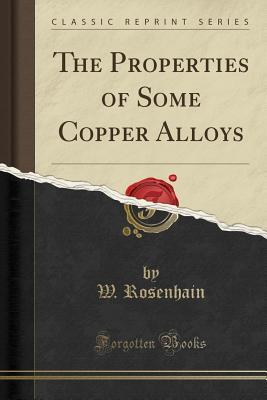Read online The Properties of Some Copper Alloys (Classic Reprint) - W Rosenhain | ePub
Related searches:
Through the 18th and 19th centuries, a copper alloy was called latten. However, sometimes latten referred to a lead alloy, tin plating on iron, or any metal prepared as a thin sheet. For this reason, copper alloys are known by more specific names today.
Brass is the generic term for a range of copper-zinc alloys with differing combinations of properties, including strength, machinability, ductility, wear-resistance, hardness, colour, electrical and thermal conductivity, and corrosion-resistance.
The properties of copper alloys which make them more ductile and corrosion resistant make them a much better choice to pure copper. Companies like kpl international are premium manufacturers of copper alloys in india. All about brazing copper and copper alloys uses of brazen joints.
Copper alloy is widely used in semiconductor industry due to its excellent conductor properties required for performance and efficiency of the product.
Copper alloys become stronger and more ductile as temperature goes down. These general characteristics have been revealed in tests on 15 copper alloys, including brasses, bronzes and commercially pure coppers.
Get periodic table facts on the chemical and physical properties of the element copper. Copper is a well-known element because of its distinctive reddish metallic color and because it occur.
Apr 6, 2013 high copper alloys have better hardness and tensile strength, but lower ductility than coppers.
Different electronic and chemical properties to see if the results can lead to some clue. In the past, there have been several reports on the use of antibacterial property of metals such as copper, silver and their alloys for water purification. Generally, this technique is used in large scale, commercial water.
High strength, high conductivity copper alloys are prime candidates for high heat flux applications in fusion energy systems. This chapter reviews the physical and mechanical properties of pure copper and copper alloys with the focus on precipitation-hardened cucrzr and dispersion-strengthened cual25 alloys.
Abstract: copper and copper alloys are some of the most versatile engineering materials available. The combination of physical properties such as strength, conductivity, corrosion resistance, machinability and ductility make copper suitable for a wide range of applications.
Jun 11, 2019 apart from cost, there are several different properties you must consider, like thermal conductivity, wear resistance, corrosion resistance,.
Here's why it's important you should you be consuming the trace mineral copper in your diet. We may earn commission from links on this page, but we only recommend products we back.
Unlike silver and gold, however, copper’s physical chemical properties differ in that in its purest form, it is soft and malleable; that is, easily bendable and workable. Every chemical is made of atoms, which are further broken down into three parts: electrons, protons, and neutrons.
Copper and copper alloys are some of the most versatile engineering materials available. The combination of physical properties such as strength, conductivity,.
Good electrical and thermal conductivity, strength, ductility and excellent corrosion resistance are just some of the properties that copper and its alloys offer. Copper alloys are grouped into families, based on their composition.
Are you worried that your home has copper pipes? just curious about what this common material is used for? this guide will help you understand common ways copper pipes are used in building construction, and what to do if you're worried abou.
The basic properties of copper alloys are largely influenced by the properties of copper itself. Copper is known to possess certain unique qualities that make it the best engineering material for bearing applications.
Some metal alloys occur naturally and require little processing to be converted into industrial-grade materials. Ferro-alloys such as ferro-chromium and ferro-silicon, for instance, are produced by smelting mixed ores and are used in the production of various steels. Yet, one would be mistaken to think that alloying metals is a simple process.
Properties of some metals and alloys copper and copper alloys • white metals and alloys • aluminum and alloys • magnesium alloys • titanium alloys • resistance heating alloys • magnetic alloys • con-trolled expansion and con-stant — modulus alloys • nickel and alloys • monel* nickel-copper alloys • incoloy* nickel-.
Copper alloys ltd is an award winning nickel-aluminium bronze producer. With a proven track record of making the world's best nickel-aluminium bronze, absolute integrity and traceability are guaranteed.
Learn about beryllium-copper alloys, which are known for their unique combination of strength, hardness and corrosion resistance. Beryllium-copper alloys are known for their unique combination of strength, hardness and corrosion resistance.
For example, electrum is a naturally-occurring alloy of gold and silver (with trace amounts of copper) that was used to make the very first metal coins in ancient history.
This page focuses on each of these metals, outlining their distinct properties, available grades, and potential applications.
Chemical properties of copper all common metals and alloys react with a moist atmosphere and corrode. Only in hot/dry (deserts) and cold/dry environments do metals resist corrosion. However, due to the chemical properties of copper, the corrosion process is very slow.

Post Your Comments: